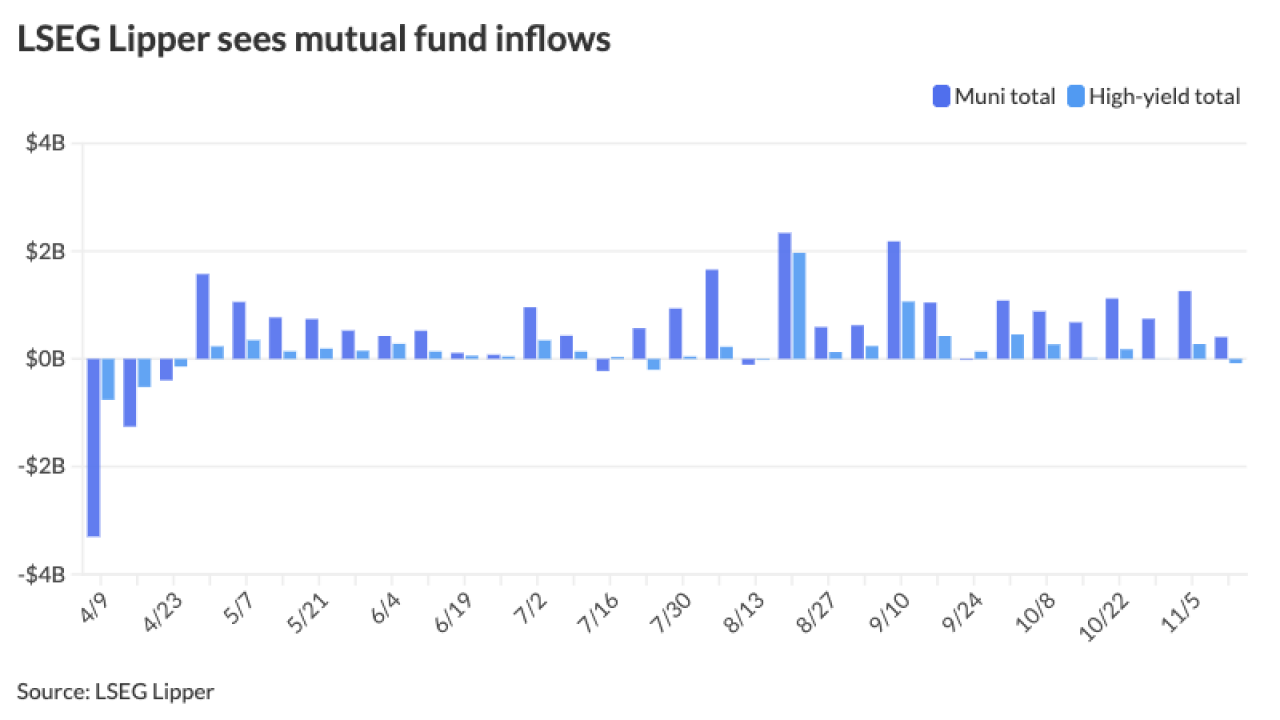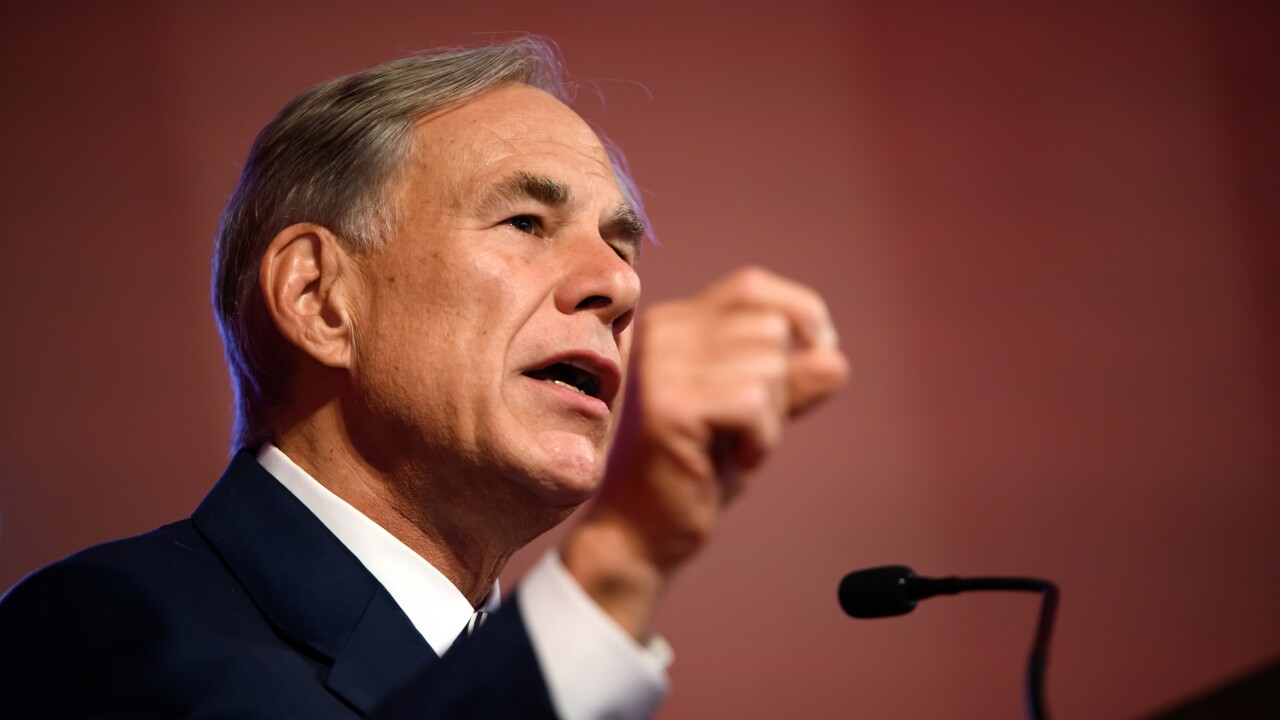Municipals were steady Thursday as U.S. Treasuries cheapened and equities sold off as the upcoming flurry of economic reports following the end of the government shutdown spurred uncertainty over the Federal Reserve's next move.
The two-year muni-UST ratio Thursday was at 69%, the five-year at 65%, the 10-year at 67% and the 30-year at 88%, according to Municipal Market Data's 3 p.m. EDT read. ICE Data Services had the two-year at 69%, the five-year at 65%, the 10-year at 67% and the 30-year at 88% at a 4 p.m. read.
"After six weeks of uncertainty, the federal government is funded and operational again," said Tom Kozlik, managing director and head of public policy and municipal strategy at HilltopSecurities.
Congress passed and President Donald Trump signed legislation to reopen the federal government Wednesday night, as "national parks, passport offices, and federal programs are resuming, and airport operations should stabilize soon," he said.
However, the agreement only extends funding through Jan. 30, 2026, setting up another "potential deadline cliff," Kozlik said.
The end of the "data blackout" carries greater weight for investors as the absence of key economic indicators left markets without a complete view, he said.
"With official data returning, portfolios can begin to recalibrate using verified numbers," Kozlik said. "The fog is lifting. While the path ahead isn't fully clear, visibility is improving."
There is a shift for muni investors from "assumption-based planning to data-informed decisions," he said.
Labor market conditions, growth expectations, and credit trends will be reassessed as new information comes out, as "each data release is likely to sharpen our view, allowing investors to move from cautious positioning toward confident, more well-informed decisions for the remainder of 2025," Kozlik said.
For munis, the end of the shutdown helps steady the backdrop, said James Pruskowski, an investor and market strategist.
"Spreads on bonds tied to federal transfer payments should tighten as headline risk fades, while better visibility from Washington will encourage more issuance," he said.
"With tax-loss swapping season in full swing, volatility and concessions are likely to rise, creating windows for more opportunistic buyers to add value," Pruskowski added.
Elsewhere, since October, munis have experienced a somewhat positive shift, said John Miller, head and CIO of First Eagle's high-yield municipal credit team.
While the asset class has lagged other fixed-income assets in total returns this year, that's more technicals, sentiment and absorbing record supply than it is anything "fundamentally wrong" with the muni market, he said.
Given all the events that have happened and how munis have held up and absorbed all this supply, things are shaping up for a strong fourth quarter, he said.
October usually is a soft month for munis. There was a "tremendous" amount of supply last month, but the muni market performed well, both on a relative and absolute basis, and this trend is continuing through November, according to Miller.
A combination of factors should bode pretty well for munis, including an estimated $48 billion of reinvestment proceeds from coupons and calls in November, and an additional estimated $53 billion of reinvestment proceeds in December, he said.
"So even if we were at a solid run rate of supply, it's not going to be nearly that high," Miller said.
Meanwhile, the amount of inflows year-to-date is similar to the amount last year over the same time period, but the "composition" differs, he noted.
This year, the "composition" is more exchange-traded funds, whereas last year, it was more mutual fund-driven, Miller said.
Both ETFs and mutual funds are currently taking in money, he said.
"So you combine that with robust reinvestment income, and then you can take different bets on the Federal Reserve meeting for Dec. 10," Miller said.
Since data has not been released in the last month, whether the Fed will cut rates again at its December meeting may depend on the influx of October data, though Miller believes the Fed will ease.
"As the Fed heads toward its December meeting, the policy path remains wide open," said Seema Shah, chief global strategist for Principal Asset Management. "To our minds, a 25-basis-point cut taking the Fed funds rate closer toward the middle of the estimated neutral range seems plausible, followed by a pause in early 2026 while officials assess the lagged effects of prior tightening."
In the primary market Thursday, Jefferies preliminarily priced for Chicago (/A+/A+/A+/) on behalf of
The second tranche, $457.745 million of non-AMT Series F bonds, saw 5s of 1/2043 at 4.01%, 5s of 2045 at 4.20%, 5s of 2048 at 4.38%, 5.25s of 2055 at 4.51% and 5.25s of 2060 at 4.59%, callable 1/1/2035.
The third tranche, $21.72 million of AMT Series G refunding bonds, saw 5s of 1/2026 at 3.25%, 5s of 2030 at 3.25%, 5s of 2035 at 3.50% and 4s of 2037 at par, callable 1/1/2035.
Wells Fargo priced for Miami-Dade County, Florida, (Aa3/AA/AA-/AA/) $993.665 million of water and sewer system revenue bonds. The first tranche, $574.525 million of Series A bonds, saw 5s of 10/2027 at 2.60%, 5s of 2030 at 2.62%, 5s of 2035 at 2.94%, 5s of 2040 at 3.53%, 5s of 2047 at 4.13%, 4.5s of 2051 at 4.65% and 5s of 2055 at 4.52%, callable 10/1/2035.
The second tranche, $419.14 million of Series B refunding bonds, saw 5s of 10/2026 at 2.68%, 5s of 2030 at 2.62%, 5s of 2035 at 2.94%, 4s of 2040 at 4.03% and 4s of 2042 at 4.15%, callable 10/1/2035.
Morgan Stanley priced for the Los Angeles Municipal Improvement Corp. (/A+/AA//) for the Los Angeles Convention Center $960.645 million of lease revenue bonds. The first tranche, consisting of $844.475 million of tax-exempt Series 2025-A, saw 5s of 5/2034 at 2.60%, 5s of 2035 at 2.74%, 5s of 2040 at 3.47%, 5s of 2045 at 4.08%, 5.25s of 2050 at 4.37%, 5.5s of 2055 at 4.44% and 5s of 2055, callable 5/1/2035.
The second tranche, $116.17 million of taxable Series 2025-B bonds, saw all bonds price at par: 4.051s of 5/2029, 4.101s of 2030 and 4.745s of 2034.
Barclays priced for the University of Delaware (Aa1/AA+//) $309.83 million of tax-exempt bonds, Series 2025A, with 5s of 11/2026 at 2.59%, 5s of 2030 at 2.51%, 5s of 2035 at 2.88%, 5s of 2040 at 3.42%, 5s of 2045 at 3.99%, 5s of 2050 at 4.27% and 5s of 2055 at 4.34%, callable 11/1/2034.
BofA Securities priced for the Central Florida Expressway Authority (Aa3/AA-//) $276.995 million of senior lien revenue bonds, Series 2025A, with 5s of 7/2029 at 2.63%, 5s of 2030 at 2.59%, 5s of 2035 at 2.93% and 5s of 2039 at 3.39%, callable 7/1/2035.
Morgan Stanley priced for the Massachusetts Development Finance Agency (Aa1/AA+//) $144.6 million of Wellesley College Issue revenue bonds, Series N, with 5s of 7/2026 at 2.56%, 5s of 2030 at 2.42%, 5s of 2036 at 2.90%, 5s of 2040 at 3.39% and 5s of 2042 at 3.65%, callable 7/1/2035.
In the competitive market, the Virginia Housing Development Authority (Aa1/AA+//) sold $102.78 million of non-AMT rental housing bonds, 2025 Series F, to Raymond James, with all bonds priced at par: 2.75s of 6/2028, 2.8s of 6/2030, 2.9s of 12/2030, 3.45s of 6/2035, 3.5s of 12/2035, 4s of 12/2040, 4.45s of 12/2045, 4.6s of 12/2050, 4.625s of 12/2056, 4.7s of 12/2061 and 4.75s of 12/2067.
Fund flows
Investors added $405.3 million to municipal bond mutual funds in the week ended Wednesday, following $1.259 billion of inflows the prior week, according to LSEG Lipper data.
High-yield funds saw outflows of $80.6 million compared to inflows of $275.2 million the previous week.
Tax-exempt municipal money market funds saw inflows of $2.194 billion for the week ending Nov. 11, bringing total assets to $143.041 billion, according to the Money Fund Report, a weekly publication of EPFR.
The average seven-day simple yield for all tax-free and municipal money-market funds fell to 2.30%.
Taxable money-fund assets saw $18.279 billion pulled, bringing the total to $7.341 trillion.
The average seven-day simple yield was at 3.63%.
The SIFMA Swap Index was at 2.45% on Wednesday compared to the previous week's 2.68%.
AAA scales
MMD's scale was unchanged: 2.54% in 2026 and 2.46% in 2027. The five-year was 2.41%, the 10-year was 2.75% and the 30-year was 4.14% at 3 p.m.
The ICE AAA yield curve was little changed: 2.55% (unch) in 2026 and 2.46% (unch) in 2027. The five-year was at 2.40% (unch), the 10-year was at 2.75% (unch) and the 30-year was at 4.10% (+1) at 4 p.m.
The S&P Global Market Intelligence municipal curve was unchanged: The one-year was at 2.54% in 2025 and 2.45% in 2026. The five-year was at 2.40%, the 10-year was at 2.75% and the 30-year yield was at 4.12% at 3 p.m.
Bloomberg BVAL was unchanged: 2.52% in 2025 and 2.47% in 2026. The five-year at 2.37%, the 10-year at 2.71% and the 30-year at 4.04% at 4 p.m.
Treasuries were weaker.
The two-year UST was yielding 3.592% (+2), the three-year was at 3.59% (+3), the five-year at 3.706% (+3), the 10-year at 4.114% (+4), the 20-year at 4.68% (+4) and the 30-year at 4.707% (+4) near the close.





